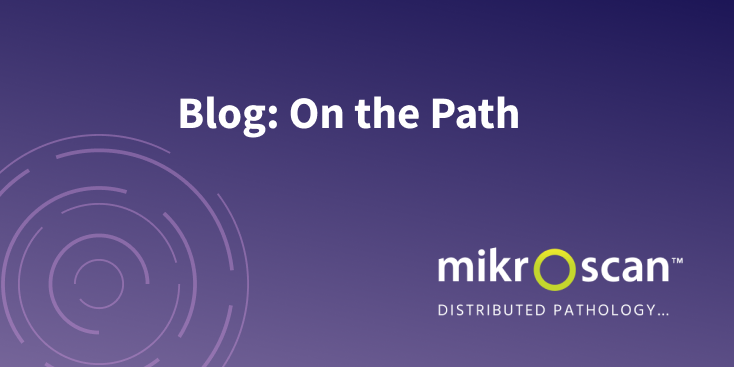
After so many years in the digital pathology field, we've come to know the answers to any question that might be posed. If you're exploring what telepathology and digital pathology can do for your workflow, read on to find the answers to the most commonly asked questions we field from new adopters.
Live Telepathology
What is live telepathology or telemicroscopy?
- Live telepathology with a Mikroscan system is truly live, where a pathologist examines a slide in real-time just as they would on their conventional microscope. The live image streams from the chosen objective and the remote pathologist has full control of the robotic microscope. Learn more about live telepathology.
How does telepathology or telemicroscopy improve patient care?
- Our telemicroscopy technology improves the quality of patient care by giving a pathologist access to a patient’s slide without the need to travel or ship the slide. This expands the patient’s access to sub-specialty pathology expertise and results in a faster diagnosis. Learn more about improving patient care.
Can I use a telepathology or telemicroscopy system for clinical applications?
- A key consideration for clinical use of live telepathology is the regulatory classification of the device. Mikroscan's L5 remotely controlled robotic microscope is registered with the FDA as a Class I Light Microscope, meaning it has the same clinical status as a traditional microscope and can be used in any diagnostic capacity—including primary diagnosis—by a board-certified professional. Our dual-mode SL5 system includes a live telepathology mode approved for primary diagnosis AND a whole-slide scanner meant for archival, QA, and research use only. Learn more about our live telemicroscopy system.
How can live telemicroscopy reduce repeat FNA procedures and improve on-site adequacy?
- An increased demand for rapid on-site evaluations of adequacy (ROSEA) has outpaced the availability of cytopathologists at many institutions, leading to unnecessary repeat FNA procedures.
Telecytology using Mikroscan’s L5 real-time telemicroscopy system addresses this problem by allowing pathologists to conveniently read slides from their offices using an autofocus capability that focuses in a fraction of a second, which is tailored for cytology slides. Learn more about on-site adequacy. Learn more about telecytology.
How can live telemicroscopy improve frozen section support?
- With live telemicroscopy, a pathologist doesn’t need to be on site for frozen section coverage, which saves travel time and frees the pathologist to review other important cases. Specialists can also be reached remotely, which ensures quick access to the best pathologist for the case. Learn more about frozen section support.
How does live telepathology improve efficiency?
- A live telemicroscopy system that uses a robotic microscope, like Mikroscan systems, fits in seamlessly with the pathology workflow, and pathologists feel immediately comfortable using it. Implementation also doesn't require extensive infrastructure changes, so setup is easy and cost-effective, allowing pathologists to hit the ground running. This increased efficiency also allows pathologists to expand their reach and generate more revenue. Learn more about improving efficiency.
How does live telepathology reduce healthcare costs?
- When hospitals employ live telemicroscopy, they experience a reduction in re-operation rates, repeat biopsies, and diagnostic errors. Using ROSE, repeat biopsy rates have been shown to decrease by 20%, a $1.5K savings per biopsy1. Learn more about reducing costs in healthcare.
Digital Pathology
What is digital pathology?
- Digital pathology systems create whole-slide digital images of pathology slides. This technology aids researchers who can perform quantitative analysis on specimens using image analysis algorithms specifically created for their application. They can also collaborate with many multi-disciplinary teams, allowing them to make more advanced discoveries in less time. Educators can also use digital slide images to teach remote and online students using an archive of rare or interesting cases. Learn more about digital pathology.
Can I use a digital pathology system (i.e., whole-slide scanner) for clinical applications?
- There are two whole-slide scanning systems on the market with FDA clearance for clinical applications, but they are for FFPE slides only, which means they cannot be used for frozen sections or fine needle aspirations. All other scanning systems are meant to be used for research, education, or archival purposes only. However, due to the COVID-19 pandemic, the FDA has issued a policy to allow the use of digital pathology devices when they are intended for use in remote reviewing and reporting of digital pathology slides. Read the FDA’s emergency use authorization. Learn more about digital pathology.
Do I have to scan every slide to benefit from digital pathology?
- You can experience the benefits of digital pathology by scanning only the slides you need. Using a low-throughput system you can scan only the slides you need for the most common clinical applications, such as remote frozen sections, consultations, tumor boards, medical education, and archival for easy retrieval. Learn more about how to adopt digital pathology.
How much does it cost to implement digital pathology?
- Digital pathology doesn't have to be expensive, especially if you start with a live telepathology system that is a fraction of the cost of a high-throughput scanner and requires none of the infrastructure expenditures. Learn more about how to affordably adopt digital pathology.
How does digital pathology improve research?
- Digital pathology systems create whole-slide digital images of pathology slides. This technology aids researchers who can perform quantitative analysis on specimens using image analysis algorithms specifically created for their application. They can also collaborate with many multi-disciplinary teams, allowing them to make more advanced discoveries in less time. Learn more about digital pathology in a research setting.
How does digital pathology improve pathology education?
- Using digitized images of glass slides hosted in the cloud, students can learn online, from anywhere, as well as collaborate with each other. Rare cases that a medical center might not otherwise have access to can be shared, expanding the breadth of knowledge. Learn more about digital pathology.


